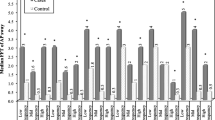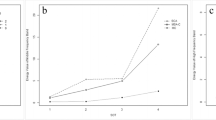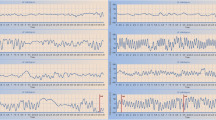Abstract
The objective of the study is to evaluate postural dysfunction of multiple system atrophy-parkinsonian type (MSA-P) and cerebellar type (MSA-C) by static posturography exam. A total of 29 MSA-P patients, 40 MSA-C patients, and 23 healthy controls (HC) were recruited and engaged in a sensory organization test (SOT). The amplitude of the postural sway was measured and transformed into energy value by Fourier analyzer. SOT scores, frequency of falls and typical 3-Hz postural tremors during the four stance tasks, and energy value in three different frequency bands were recorded and compared. Compared with HC, SOT scores were significantly lower in MSA groups (P < 0.01). Compared with MSA-P, the vestibular scores were further reduced in MSA-C patients (P < 0.05). Falls were more frequent in MSA groups, especially in SOT4 task (foam surface with eyes closed) or in MSA-C group (P < 0.05). Typical 3-Hz postural tremor was observed in 97.5% MSA-C patients, in 24.1% MSA-P patients but in none of the HC (P < 0.05). Compared with HC, much more energy was consumed in every task, every direction, and nearly every frequency band in MSA groups. Energy value of MSA-C group was significantly higher than that of MSA-P, especially in higher frequency band (2 ~ 20 Hz) or in more difficult stance tasks (SOT 3 ~ 4, foam surface with eyes open or closed) (P < 0.05). Both MSA-P and MSA-C were characterized by severe static postural dysfunction. However, typical 3-Hz postural tremor was predominant in MSA-C and was very useful in the differential diagnosis between MSA-P and MSA-C.

Similar content being viewed by others
References
Krismer F, Wenning GK (2017) Multiple system atrophy: insights into a rare and debilitating movement disorder[J].Nat. Rev Neurol 13(4):232–243
Kollensperger M, Geser et al (2008) Red flags for multiple system atrophy[J]. Mov Disord 23(8):1093–1099
Wenning GK, Kraft et al (1997) Cerebellar presentation of multiple system atrophy[J]. Mov Disord 12(1):115–117
Tison F, Yekhlef F, Chrysostome V et al (2002) Parkinsonism in multiple system atrophy: natural history, severity (UPDRS-III), and disability assessment compared with Parkinson's disease[J]. Mov Disord 17(4):701–709
Gilman S, Wenning GK, Low PA et al (2008) Second consensus statement on the diagnosis of multiple system atrophy[J]. Neurology 71(9):670–676
Alfieri FM, Riberto et al (2012) Effectiveness of an exercise program on postural control in frail older adults[J]. Clin Interv Aging 7:593–598
Magnusson M, Enbom et al (1990) Significance of pressor input from the human feet in lateral postural control. The effect of hypothermia on galvanically induced body-sway[J]. Acta Otolaryngol 110(5–6):321–327
Gatev P, Thomas S, Kepple T et al (1999) Feed forward ankle strategy of balance during quiet stance in adults[J]. J Physiol 514(Pt 3):915–928
Kiers H, van Dieen J, Dekkers H et al (2013) A systematic review of the relationship between physical activities in sports or daily life and postural sway in upright stance[J]. Sports Med 43(11):1171–1189
Hayashi R, Tako et al (1997) Three-Hertz postural oscillation in patients with brain stem or cerebellar lesions[J]. Electromyogr Clin Neurophysiol 37(7):431–434
Mauritz KH, Schmitt C, Dichgans J (1981) Delayed and enhanced long latency reflexes as the possible cause of postural tremor in late cerebellar atrophy[J]. Brain 104(Pt 1):97–116
Ubhi K, Low P, Masliah E (2011) Multiple system atrophy: a clinical and neuropathological perspective[J]. Trends Neurosci 34(11):581–590
Matsushima M, Yabe I, Oba K et al (2016) Comparison of different symptom assessment scales for multiple system atrophy[J]. Cerebellum 15(2):190–200
Alfieri FM, Riberto M, Abril-Carreres A et al (2012) Effectiveness of an exercise program on postural control in frail older adults[J]. Clin Interv Aging 7:593–598
Diener HC, Dichgans J, Bacher M et al (1984) Quantification of postural sway in normals and patients with cerebellar diseases[J]. Electroencephalogr Clin Neurophysiol 57(2):134–142
Acknowledgements
None declared by the authors.
Author information
Authors and Affiliations
Corresponding author
Ethics declarations
Conflict of interest
The authors declare that they have no conflict of interest.
Ethical approval
This study was approved by the ethics committee of Guangdong 999 Brain Hospital.
Rights and permissions
About this article
Cite this article
Li, X., Wang, Y., Wang, Z. et al. 3-Hz postural tremor in multiple system atrophy cerebellar type (MSA-C)—a static posturography study. Neurol Sci 39, 71–77 (2018). https://doi.org/10.1007/s10072-017-3130-3
Received:
Accepted:
Published:
Issue Date:
DOI: https://doi.org/10.1007/s10072-017-3130-3




